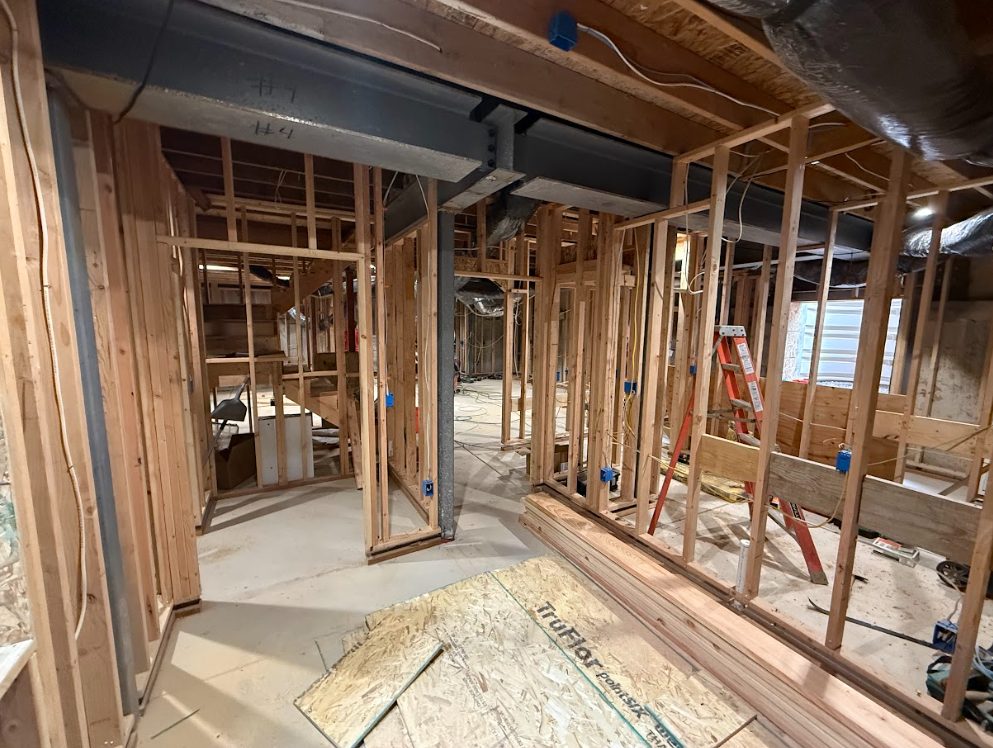by Luke Cronin
Share
by Luke Cronin
Share

When renovating your home, you might dream of open spaces and flexible layouts. Removing a load-bearing wall can transform your house into a modern masterpiece. But it’s not as simple as grabbing a sledgehammer. Let’s explore the essentials of tackling this task safely and effectively.
What Is a Load-Bearing Wall?
A load-bearing wall is integral to your home’s structure, acting as a backbone that supports weight from the roof, upper floors, and walls above it. Unlike non-load-bearing walls, which simply divide space, load-bearing walls are vital for transferring the load safely down to the foundation. When you remove one, you’re essentially altering how your home stands. How do you identify which walls are load-bearing and which ones are not?
Key Differences
- Load-Bearing Walls:
- Support weight from the roof, upper floors, and walls.
- Transfer the load safely down to the foundation.
- Critical to the home’s structural integrity.
- Non-Load-Bearing Walls:
- Simply divide space.
- Can be shifted or removed with fewer complications.
- Do not support any weight from the structure.
Important Considerations
Before you swing that sledgehammer, it’s crucial to grasp your home’s structural layout:
- Blueprint Analysis:
- Review your home’s blueprints if available.
- Identify which walls are load-bearing.
- Consulting an Expert:
- Consider hiring a professional or structural engineer to assess your home’s layout.
Understanding the distinction between load-bearing and non-load-bearing walls isn’t just savvy; it’s essential for the safety and longevity of your home. Attempting to remove or alter load-bearing walls without proper knowledge can result in structural issues and potential safety hazards.
Can You Remove a Load-Bearing Wall?
Sure, you can remove a load-bearing wall, but it’s not a DIY project for the faint of heart. First off, it’s crucial to identify if the wall is indeed load-bearing. Once confirmed, go beyond the instinct to grab tools and instead reach for your phone to connect with a structural engineer. Why? Because your house relies on these walls for support—take one out, and you could be compromising the whole structure.
Structural engineers don’t just inspect; they provide solutions. You might need a hefty beam to redistribute the weight, and they’ll tell you whether steel or wood fits your needs and budget. If they give you the green light for removal, you’ll still need to get necessary permits and hire a contractor who knows their stuff.
But sometimes, removing a load-bearing wall isn’t feasible, either due to structural limitations or costs. In these cases, explore alternatives, like creating larger doorways or openings instead, to achieve that open-concept feel without a full teardown. The key takeaway? Always consult a pro before swinging the sledgehammer. Your dream space could turn into a load-bearing nightmare without expert guidance.

How Much Does It Cost to Remove a Load-Bearing Wall?
Let’s talk dollars and cents. When removing a load-bearing wall, cost is one of the primary concerns homeowners face. The price tag on this project isn’t one-size-fits-all—it fluctuates depending on several factors. First off, consider the size of the wall. A larger wall involves more work and materials, increasing the overall cost. Additionally, the type of materials you’re dealing with (drywall, plaster, brick, etc.) can also have a significant impact on the price.
Expect surprises along the way. Setting aside a contingency budget for unexpected expenses can save a lot of stress. Hidden electrical wiring or plumbing concealed within the wall are common issues that can drive up costs. Hiring a qualified structural engineer and contractor who can give a thorough assessment beforehand is crucial to getting a realistic budget.
Speaking of figures, rough estimates range anywhere from $2,000 to $10,000 or more, depending on the complexity of the project. For instance, a simple single-story wall removal might stay on the lower end, while integrating structural support beams for a double-story house could steer you toward the higher end. Remember, quality never comes cheap, and investing in experienced professionals is worth every penny to avoid potential safety hazards and ensure a smooth process.
Steps to Safely Remove a Load-Bearing Wall
Taking down a load-bearing wall isn’t a weekend DIY project. It requires a meticulous approach and respect for your home’s structural integrity. Here’s how to tackle it in a few straightforward steps:
- Planning and Permits: Before you do anything, it’s crucial to plan thoroughly. Evaluate your home’s layout and structural diagrams. You’ll need to obtain necessary permits, as structural changes usually require compliance with local building codes.
- Hiring the Right Pros: This isn’t a solo venture. Get a structural engineer to validate your plans and assess the impact on your home. A contractor with experience in structural modifications should handle the physical work. Their expertise ensures safety and adherence to building regulations.
- Preparation Phase: Before demolition begins, prepare the area. Ensure utility lines—like electrical and plumbing—that may run through the wall are safely rerouted. Empty spaces on either side of the wall to create a safe working environment.
- Temporary Support Structures: Erect temporary support, such as adjustable steel props with strong timber planks, to bear the load while the wall is removed. This step is critical to avoid any unwanted sag or structural damage.
- Demolition: With supports in place, it’s time for controlled demolition. Remove sections of the wall carefully, starting with drywall and finishing with the studs. Always double-check that the temporary structures are holding as expected.
- Installing Permanent Supports: The key to a successful wall removal is a permanent load-carrying replacement, such as a beam or columns. Install these as per the design specified in your plans, making sure they fit securely and bear the necessary load.
- Inspection and Finishing Touches: Once the new supports are in place, bring in a building inspector to ensure everything meets code requirements. Then, tidy up the space—patch, paint, and finish the surfaces to blend with your updated layout.
Approaching this task with diligence and professional support paves the way for a safe and stylish transformation.

Non-Load Bearing Walls: Easier Alternatives
Choosing to remove a non-load bearing wall is like taking a leisurely drive instead of navigating a construction zone. These walls, unburdened by structural duties, suggest straightforward renovation options that can reshape your space without the engineering headaches.
Definition and Examples of Non-Load Bearing Walls
Non-load bearing walls, unlike their supportive counterparts, do not hold up any weight above them. Their job is simple: divide and define spaces. Think of them as the flexible partitions in your office cubicle farm. They can be found separating rooms such as bedrooms, hallways, or bathrooms. Picture that wall separating your living room from the dining area, potentially ready to be nudged away for a more expansive flow.
Considerations for a Simpler Renovation
The beauty of dealing with non-load bearing walls lies in their simplicity. Without the need for structural reinforcements or complex architectural consultations, the job becomes more like a weekend project. Still, precautions shouldn’t be tossed aside. Hidden plumbing, wiring, or ductwork can pose unexpected challenges. A little exploratory surgery—cutting a small hole to peek inside—might save you from future surprises.
How to Adjust Your Plans Involving Non-Load Bearing Walls Instead
Before swinging the hammer, adjust renovation plans to consider the simplicity of these walls. If your original grand vision revolved around knocking down a prohibitive load-bearing wall, rethink how opening just the non-load bearing sections can still offer a transformative effect. Sometimes, selectively removing and adding partial walls, rather than an entire wall, can maintain privacy while enhancing openness. Flexibility and creativity go a long way when you’re not grappling with the heavy lifting.
Removing a Load-Bearing Wall in the Kitchen

Creating an open kitchen by removing a load-bearing wall can redefine your living space, ushering in a fluid, airy atmosphere perfect for socializing and multitasking. However, the allure of a spacious kitchen comes with its own set of challenges.
Structural Considerations
- Consult a Structural Engineer: Before making any modifications, understand the structural consequences. Professional advice can prevent future problems.
- Utilities and Systems: Kitchens often house a network of utilities—plumbing, electrical, and gas lines. Consider:
- Rerouting systems and factoring in the associated time and cost.
- Ensuring proper ventilation, as kitchen walls might contain crucial ductwork.
Support Beams: Function and Design
- Role of Support Beams: Once a load-bearing wall is removed, support beams are essential to maintain structural integrity.
- Design Considerations: While beams can feel like obstructions, with careful design, they can become stylish focal points.
- Options include exposed wood for a rustic touch or sleek steel for a modern aesthetic.
- Beams can double as functional features like shelving or light placements.
Integrating Beams into Kitchen Design
- Seamless Incorporation: Think of support beams as design opportunities, not obstructions.
- Aesthetic and Functional Adjustments: Whether for aesthetics or functionality, these adjustments add character and ensure your home’s safety and integrity.
By tackling these considerations, you can successfully create an open kitchen that not only improves aesthetics but also maintains structural soundness.
Post and Beam Home Designs: A Unique Consideration
Post and beam homes stand out with their rustic elegance and structural honesty. Unlike traditional framed homes, they rely on heavy timber supports rather than load-bearing walls, giving a more open architectural canvas. This design uses vertical posts and horizontal beams to bear loads, allowing walls to be more for partitioning space than structural necessity.
If you’ve got your heart set on knocking down a wall in such a home, you’re in luck: it’s often feasible without shaking the structural integrity. However, before swinging that hammer, walk through your plan with a fine-tooth comb. Despite appearances, not all walls in a post and beam setup can vanish without a trace of care. Pay special attention to any added walls that may have been structured to support second-floor joists or even roof weight over time.
Successful renovation in these homes often means emphasizing the inherent structure—highlighting and celebrating those robust beams while reconfiguring space. Think of working with an architect familiar with such designs to fuse function with style artfully. Adaptable layouts can transform spaces with fewer barriers and more flow, providing that open concept you crave with minimal structural fuss.
Strategically placed support and creative design choices can turn your post and beam home into a paragon of modern living without sacrificing the original charm or inadvertently compromising its ingenious framework.
Renovating your home can feel like shaping a new chapter in your life, bringing a refreshed sense of space and style. As we’ve explored, removing a load-bearing wall is no small feat—it’s a task that demands precision, planning, and partnership with the right professionals. From understanding the vital role these walls play in your home’s structure to navigating the costs and the choice of materials, each step is crucial.
Before you take that first swing, remember that consulting with structural engineers and experienced contractors isn’t just beneficial; it’s essential. Their expertise can help mitigate risks, ensuring your dream design doesn’t compromise safety or integrity.
For those still curious about this transformative process, diving deeper into resources like Removing a Load-Bearing Wall can provide further insights. With the right information and guidance, you’re well on your way to creating a modern, open space you’ll love. Whether it’s the airy kitchen you’ve always wanted or a seamless living area that breathes new life into your home, embracing the journey can lead you from blueprint to breakthrough.

